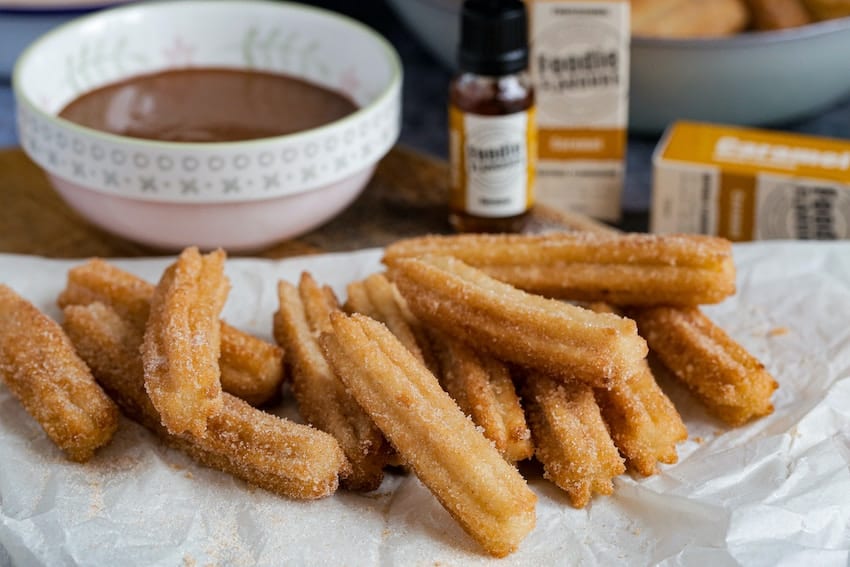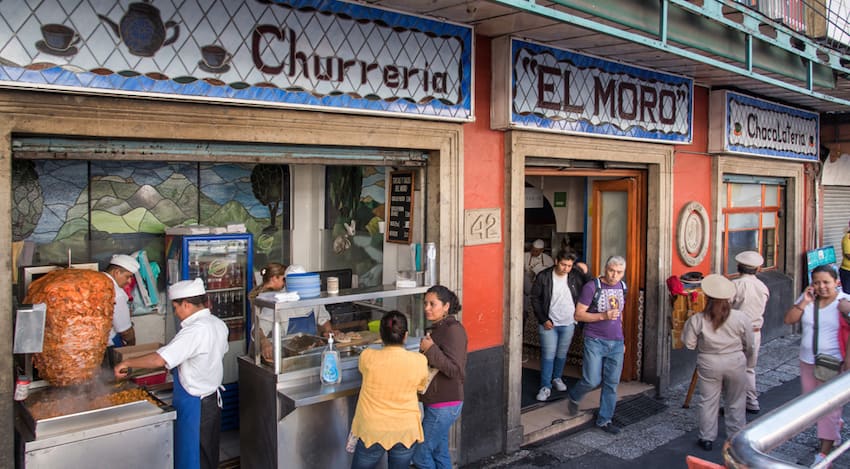a delicious treat with an ancient history

The ubiquitous churro is a favorite snack in both Mexico and Spain. Sticks of fried dough rolled in sugar and cinnamon are eaten throughout both countries. One bite of this deliciousness and you will also be a fan of the delectable treat. Traditionally, Spaniards and Mexicans dip churros in their cup of hot chocolate, but they can also be dipped in the chocolate-based atole called champurrado, dulce de leche or café con leche.
Given its popularity in Mexico, many believe that the churro originated here. In fact, though its origins are controversial, we know that neither churros nor fried dough were invented in Mexico. One theory holds that fried dough first appeared in Ming dynasty China (1368- 1644) as youtiao and was brought back to the Iberian Peninsula by Portuguese traders.
Spanish chef Jose Antonio Navarro, who has worked in both Hong Kong and Spain, believes churros were influenced by the fried dough made in China. “The Portuguese likely brought the concept to Spain and through the centuries we mastered the technique to make them. I think we mastered a recipe originating in China,” he told the South China Morning Post in 2021.
Another theory however is that churros were invented by Spanish shepherds as a substitute for fresh baked bread. Shepherds spent most of their time in the mountains and churros were convenient to make as they could be fried over an open fire. This theory is bolstered by the fact that churros resemble the horns of the Spanish Churra sheep, and their descendants, the Navajo-Churro sheep.
Many scholars believe churros and Chinese fried dough sticks had a common ancestor: the Middle Eastern zulabiya. They say fried dough was known throughout the ancient Mediterranean world. Food historian Michael Krondl told the BBC in June that “today’s churro is not that different from a recipe for a flour and water fritter you find in ‘Apicius’, a Roman cookbook dating from the 1st century AD.”
“The trouble is that fried dough strips and frybread are almost impossible not to invent, if you have dough and oil,” anthropologist Gene Anderson told the SCMP. “They are thus pretty widespread.” He believes that fried dough may be even older than that, based on recipes from the ancient Greeks.

Despite the controversy over their origins, one fact that is not in dispute is that the Spanish conquistadores brought churros to Mexico in the 16th century. The addition of hot chocolate came from Mexico. Already consumed for thousands of years when the Spanish arrived, cacao had religious and social significance across Mesoamerica. The letters of Hernán Cortés claim that the Mexica emperor Moctezuma II consumed 500 bowls of the drink xocolatl each day.
Churros are sold in churrerías, pastry shops and from stalls or carts. Madrid’s most famous churrería is Chocolatería San Ginés which opened its doors in 1894 and turns out 80,000 to 90,000 churros a day! They serve churros and hot chocolate to two million customers a year.
When Spanish immigrant Francisco Iriate came to Mexico City in the 1930s, he was dismayed to discover there were no churrerías in the city. He started selling his favorite treat from a cart downtown, naming it El Moro (The Moor) after the nickname of a churro vendor from his hometown. They were a big hit and in 1935, he established the first branch of El Moro a few blocks from the historic Zócalo, making it the oldest churrería in Mexico City. The popular family-owned churrería now has 15 locations in Mexico.
My favorite way to eat churros is from a churro cart, where I can watch the whole process. The batter for churros is very basic, just flour, water and a pinch of salt mixed together to get a pale, sticky, unappetizing blob of dough. The magic happens in the frying.

Being a churrero requires skill and practice. There is a technique to prepare the perfect churros. While you wait in line the churrero carefully watches the oil to make sure it reaches the right temperature. They know when it is ready by the ripples and shimmering on the surface. When the oil is hot enough, they pipe the dough from a churrera which resembles a canister or large syringe with a crank, cutting each stick of dough into the same length with a knife or scissors. If the oil is not hot enough, the churros will absorb the oil; too hot and the churros will burn. In the shimmering hot oil they slowly rise to the surface and bob around in a fury of bubbles and steam.
As your mouth waters in anticipation, the churrero uses a strainer to move the churros around, making sure they brown evenly. When they reach the right color, the churros are removed with the strainer and rolled in a mixture of sugar and cinnamon. Served in small paper bags, they are best eaten while still warm and should be crispy and sweet on the outside and fluffy on the inside.
Churros are so popular that they have their own holiday – National Churro Day – on June 6. But, as any Mexican will tell you, any day is a good day to eat churros.
Sheryl Losser is a former public relations executive and professional researcher. She spent 45 years in national politics in the United States. She moved to Mazatlán in 2021 and works part-time doing freelance research and writing.
Source: Mexico News Daily

